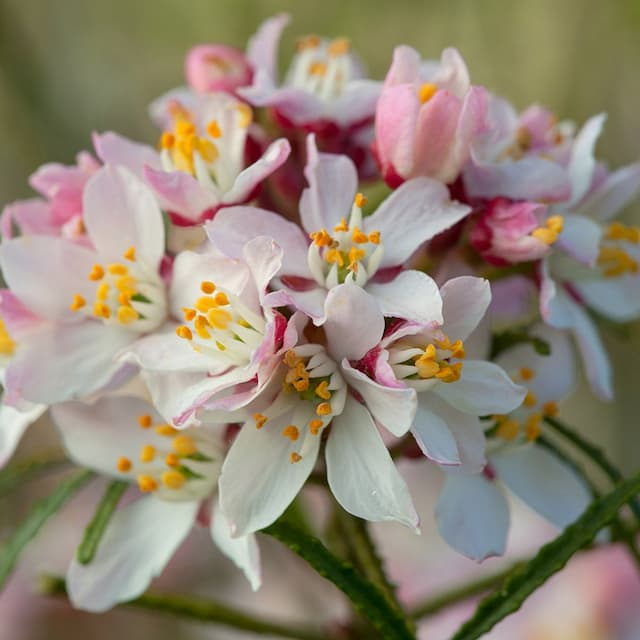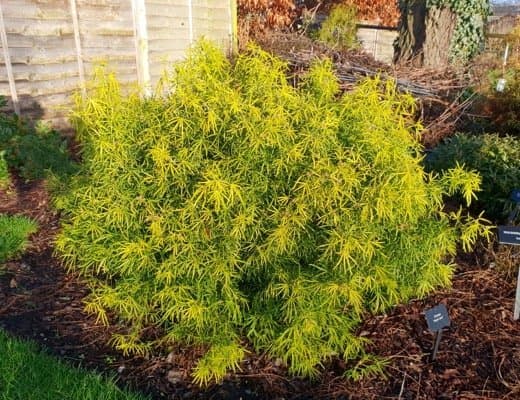Confetti Bush Diosma ericoides L.

ABOUT
Commonly known as the confetti bush, this plant exhibits a fine texture with its needle-like leaves that resemble those of heather. The foliage is dense and evergreen, showcasing a rich, dark green color that remains vibrant throughout the year. The plant is adorned with small, star-shaped flowers that are generally white or pink, blooming profusely and producing an airy, delicate appearance. These blossoms often emit a pleasant fragrance and are noticeable during the flowering season, attracting various pollinators to the garden. The confetti bush's overall form is rounded and bushy, contributing to its use as an attractive ornamental addition to landscapes. Its distinctive foliage and charming flowers make it a popular choice for border planting, rock gardens, and as part of aromatic herbal compositions.
About this plant
 Names
NamesFamily
Rutaceae
Synonyms
Cape May, Golden Diosma, Breath Of Heaven
Common names
Coleonema album, Coleonema calendulaceum, Coleonema ericoides, Diosma ericoides var. brevifolia, Diosma ericoides var. odorata, Diosma oppositifolia, Diosma pulchra, Hartogia ericoides, Hartogia pulchra.
 Toxicity
ToxicityTo humans
The plant Diosma ericoides L., commonly known as Buchu, has a history of traditional medicinal use, particularly in South Africa, where it originates. As of my knowledge cutoff date in 2023, there have been no widely reported cases of toxicity to humans from Buchu. However, it is important to note that any plant may cause a negative reaction if ingested improperly or in large quantities. If there are any undiscovered or unreported toxicities in Buchu to humans, they could potentially range from mild gastrointestinal disturbances to more serious effects, depending on the amount consumed and the individual's sensitivity. Always consult with a healthcare professional before ingesting plants for medicinal purposes.
To pets
The common Buchu plant, Diosma ericoides L., does not have widely reported cases of toxicity in pets. However, the absence of evidence is not evidence of absence, and individual animals may have unique sensitivities or allergic reactions to plants that are generally considered non-toxic. If a pet ingests part of a Buchu plant and exhibits symptoms of poisoning, such as vomiting, diarrhea, lethargy, or abnormal behavior, it is advisable for pet owners to seek veterinary attention. It is always a good practice to keep an eye on pets around plants and to prevent them from ingesting unknown foliage.
 Characteristics
CharacteristicsLife cycle
Perennials
Foliage type
Evergreen
Color of leaves
Green
Flower color
Pink
Height
3 feet (0.9 meters)
Spread
3 feet (0.9 meters)
Plant type
Shrub
Hardiness zones
8
Native area
South Africa
Benefits
 General Benefits
General Benefits- Ornamental value: Diosma ericoides, commonly known as Breath of Heaven, adds aesthetic appeal to gardens with its delicate pink or white flowers and fine, needle-like foliage.
- Drought tolerance: Once established, it's quite drought-resistant, making it suitable for water-wise gardens.
- Scented foliage: The plant has fragrant foliage, which releases a pleasant scent when brushed against or crushed, contributing to the sensory garden experience.
- Attracts pollinators: The flowers of Breath of Heaven attract bees, butterflies, and other beneficial pollinators, supporting local biodiversity.
- Low maintenance: Diosma ericoides is generally low-maintenance, requiring minimal care once established in a suitable location.
- Soil adaptability: It adapts well to various soil types, although it prefers well-drained conditions, making it versatile for different garden settings.
- Wind resistance: The plant can withstand windy conditions, making it suitable for coastal gardens or exposed sites.
- Privacy and screening: When planted in groups or as a hedge, Diosma ericoides can provide privacy and screen unsightly views with its dense growth habit.
- Erosion control: The plant's root system can help stabilize slopes and prevent soil erosion.
- Fast-growing: Breath of Heaven is relatively fast-growing, which allows for quick establishment in the garden.
- Compact size: With its moderate size, it fits well in smaller gardens without overwhelming the space.
 Medical Properties
Medical Properties- Anti-inflammatory: Diosma ericoides may possess properties that help reduce inflammation.
- Antimicrobial: The plant could have the ability to inhibit the growth of certain bacteria or fungi.
- Diuretic: It is suggested to have diuretic effects, promoting the production of urine.
- Antioxidant: Diosma ericoides might contain compounds that can neutralize free radicals, potentially preventing cellular damage.
 Air-purifying Qualities
Air-purifying QualitiesThis plant is not specifically known for air purifying qualities.
 Other Uses
Other Uses- Diosma ericoides, commonly known as Buchu, can be used in the garden as a decorative, low-maintenance hedge due to its fine, heather-like foliage and small, starry flowers.
- The plant can serve as a companion plant in agricultural settings, repelling pests with its strong scent, thus protecting neighboring crops without the use of chemical insecticides.
- Buchu essential oil, derived from the leaves of the plant, is used in the fragrance industry for its unique, minty aroma to create perfumes and scented products.
- The leaves of Buchu can be used to impart a flavor to preserves and pickles, lending a unique taste to culinary creations.
- It can be used in potpourri mixes because of its strong, pleasant scent, which helps freshen and deodorize living spaces.
- Buchu’s aromatic leaves can be infused in hot water to create a flavorful and aromatic foot soak or bath additive.
- The dried leaves of the plant are sometimes used as an insect repellent for clothes and linens, warding off moths and other insects.
- This plant can be utilized in the craft of making botanical dyes, where its leaves produce dyes for fabrics or natural fibers.
- In floral arrangements and wreath-making, Buchu branches may add a delicate, fine-textured element to the composition.
- Gardeners may use the plant as a natural border marker, due to its consistent growth habit and the ease of trimming it into formal shapes.
Interesting Facts
 Feng Shui
Feng ShuiThe Diosma is not used in Feng Shui practice.
 Zodiac Sign Compitability
Zodiac Sign CompitabilityThe Diosma is not used in astrology practice.
 Plant Symbolism
Plant Symbolism- Purification: Diosma ericoides, commonly known as "Breath of Heaven," is often associated with purification due to its clean, refreshing scent that is released when its leaves are brushed or crushed.
- Protection: The plant has been traditionally used in gardens and homes as a symbol of protection, perhaps stemming from the belief that its strong aroma could ward off evil spirits or negative energies.
- Inspiration: With its name "Breath of Heaven," this plant is also sometimes linked to inspiration, creativity, or divine guidance, suggesting a connection to celestial or spiritual realms.
- Beauty: The delicate appearance of its flowers and fine foliage often symbolizes beauty and the appreciation of subtle elegance in the natural world.
 Water
WaterThe Breath of Heaven (common name for Diosma ericoides L.) prefers regular watering, especially during the growing season in spring and summer. It should be watered deeply once or twice a week, depending on the weather conditions and soil drainage. Ensure the plant receives about 1 inch (which is approximately 0.62 gallons) of water each time. During winter months, reduce the frequency but don’t let the soil become completely dry. Adjust the watering schedule based on rainfall and temperature, as the plant is drought-tolerant once established but thrives with consistent moisture.
 Light
LightBreath of Heaven thrives in full sun to partial shade. It is best to place it in a spot where it will receive at least six hours of direct sunlight per day, but it can also tolerate some afternoon shade, especially in hotter climates. An east or west-facing spot can provide the ideal light conditions, ensuring a balance of sun and light shade to keep the plant healthy.
 Temperature
TemperatureBreath of Heaven prefers moderate temperature conditions and can tolerate a range between 20°F and 100°F. However, the ideal temperature for this plant is between 50°F and 75°F. It is reasonably frost-hardy but may need protection if temperatures dip below 20°F, as prolonged exposure to extreme cold can damage the plant.
 Pruning
PruningPrune the Breath of Heaven during late winter or early spring before new growth begins. This helps maintain the plant's shape, encourages bushiness, and removes any dead or damaged branches. Pruning could be done annually, and during this time, it’s also a good opportunity to cut back any overgrowth to keep the plant looking tidy. The best time to prune is after the last frost has passed to avoid frost damage to new cuts.
 Cleaning
CleaningAs needed
 Soil
SoilConfetti Bush thrives in well-draining soil mixed with sand, peat, and some compost to ensure proper drainage and aeration. This plant prefers a slightly acidic to neutral pH, ideally ranging from 5.5 to 7.
 Repotting
RepottingConfetti Bush should be repotted every 2 to 3 years to refresh the soil and accommodate root growth. It's best to repot in spring before new growth starts.
 Humidity & Misting
Humidity & MistingConfetti Bush does well in moderate humidity levels but is quite adaptable and doesn't require specific humidity conditions for healthy growth.
 Suitable locations
Suitable locationsIndoor
Place in bright, indirect light and avoid overwatering.
Outdoor
Plant in full sun, shelter from strong winds.
Hardiness zone
8-10 USDA
 Life cycle
Life cycleDiosma ericoides L., commonly known as Honey Bell Bush, begins its life cycle as a seed, which germinates after a period of moisture to give rise to a seedling. The seedling establishes itself and gradually develops into a juvenile plant with a characteristic dense, fine-leafed shrub form. As it reaches maturity, the Honey Bell Bush produces small, star-shaped pink to white flowers, typically blooming from late winter to early spring. These flowers are hermaphroditic, containing both male and female reproductive structures, which allow for self-pollination or pollination by insects. Following successful pollination, the flowers develop into small, rounded capsules, which eventually dry and release seeds, thus completing the reproductive cycle. Throughout its life, the Honey Bell Bush can be pruned to maintain shape and encourage denser growth, with the plant potentially living for many years under favorable conditions.
 Propogation
PropogationPropogation time
Spring-early summer
The closely related and more commonly known Breath of Heaven (Coleonema pulchellum) which also belongs to the Diosma genus, can typically be propagated through semi-hardwood cuttings. This method is often the most popular for Breath of Heaven and likely for Diosma ericoides as well, since both plants share similar characteristics. The optimal time for taking cuttings is in late summer or early fall. To propagate, one should select healthy semi-hardwood stems that have matured slightly but are not fully woody. Cut a 4 to 6-inch (10 to 15 cm) length of stem just below a leaf node and remove the leaves from the lower half. The cut end can then be dipped in rooting hormone to enhance root development. Finally, place the cutting in a well-draining potting mixture and keep it moist and in indirect light until roots have established, which typically takes several weeks.









